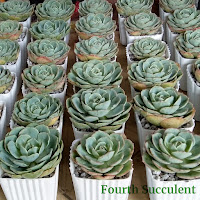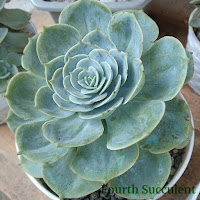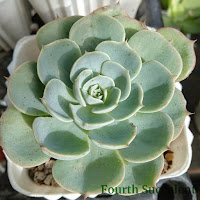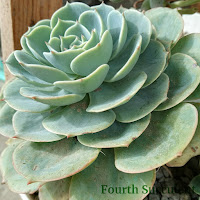Being a popular and super common succulent, it is an ideal choice as a souvenir plant for various events such as weddings, birthdays or baptisms.
Echeveria 'Imbricata' (Rose Cabbage) Succulent
Echeveria 'Imbricata' is a hybrid between Echeveria secunda 'Glauca' and Echeveria gibbiflora 'Metallica'.It has gray-green leaves that turn powdery blue (visibly when it has a thick farina) with pink tips when it is stressed (exposed to extreme cold or sun exposure).
Rose Cabbage succulent has red and yellow flowers that appear in clusters on branched, arching inflorescences and can grow up to 8 inches in diameter. The offsets grow freely on the base/stem of the matured plant.
Echeveria 'Imbricata' Care Tips
How to grow and take care of Rose Cabbage in tropical monsoon climates
Light:- Gradual exposure to direct sun light
- Full sun on dry, cooler months / growing season (partial shade or filtered sun during noon time is recommended).
- Full-filtered sun on summer / hotter months (usage of shade net or cloth is recommended to avoid sunburn).
- Fast-draining, gritty soil mix.
- We can create our own DIY soil mixes (usually 70% inorganic and 30% organic) or buy a commercially available soil mix for succulents.
- Rainwater is highly recommended to use. If there's none, tap water will suffice.
- For cuttings or trimmed roots, do not water until new roots started to grow (risk of getting rotten).
- For newly potted, especially with trimmed roots, we can wait for at least a week before introducing minimal drops of water to the plant.
- If it's already stable, we can water it using the "soak and dry method" where we only water when the soil is completely dried.
- Although Echeveria 'Imbricata' can be a "rain-or-shine" succulent, it is recommend to place them in a shaded area where it is safe from continuous, heavy rains for several days.
- Shallow and wide pot is recommended for Echeverias
- An area with good air circulation.
- Preferably placed above the ground (especially if your area is located in lowland).













Comments
Post a Comment